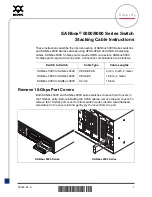
Lantronix
SMxTAT2SA Install Guide
33716 Rev. L
24
Calculate PoE Power Budget
To calculate how many 802.3at devices the unit supports, divide the Total PoE Budget (130 Watts) by 30 Watts.
To calculate the maximum number of 802.3af devices, divide the Total PoE Budget (130 Watts) by 15.4 Watts.
Mixing POE and Non-POE Devices
You can mix POE and non-POE devices on the same POE switch (i.e., you can put PCs on the same POE switch
as a SIP phone or a VOIP phone). The PSE (your switch) will only send power if requested by the PD.
Ethernet and PoE Intra-Building Cabling Warnings
1. Ethernet cables are intended for intrabuilding use only. Connecting your Lantronix switch directly to Ethernet
cables that run outside the building in which the switch is housed will void the user's warranty and could
create a fire or shock hazard.
2. PoE cables are intended for intrabuilding use only. Connecting your Lantronix switch directly to PoE cables
that run outside the building in which the switch is housed will void the user's warranty and could create a fire
or shock hazard.
3. For outdoor PoE applications, we recommend using Lantronix' SI-IES-1200-LRT Unmanaged Hardened
PoE+ Injector or SI-IES-111D-LRT Unmanaged Hardened PoE+ Injector/Converter Use of any other PoE
injector will void the user's warranty and could create a fire or shock hazard.
Legacy PD Detection / Capacitor Detection
Legacy PDs refers to powered devices manufactured before the IEEE standard was finalized and do not have the
expected PD signature required by the PSE's detection signal. Such PDs usually feature large capacitance as the
detection signature that does not completely comply with the 802.3af specs. By enabling this option, the switch
will probe for legacy PDs and if a legacy PD is detected, the switch will provide power to the PD.
Troubleshooting PoE Problems
1. Get as much detail as possible regarding the symptom, including any system messages from the PoE switch.
For example, does a PD not power up at all, or does it power up briefly and then power down?
2. Determine if the trouble occurred on initial installation or after the PD had been working normally?
3. If the trouble started after the PD was working, what changed? Any hardware or software changes?
4. Verify that the port is not shut down, disabled, or errored.
5. Verify that the Ethernet cable from the PD to the switch port is good.
6. Verify that the total cable length from the switch front panel to the connected PD is not more than 100 meters.
Some of the power from the switch port is dissipated in the cable due to wire resistance, especially on cables
as long as 100 meters. Only the remaining power is available to the PD. The 100-meter limit for twisted-pair
Ethernet cable assumes
a)
not more than four RJ-45 connection points in the transmission path,
b)
90 meters
of solid-strand Category 5 or 5e, and
c)
10 meters of flexible multistrand cable (2-to-5 meters of multistrand
Category 5 patch cords).
7. Verify that the PSE switch power budget can power the PD. If the switch power budget is depleted, additional
PDs will not power-on when connected to a PoE port. Verify that the switch power budget (available PoE) is
not depleted before or after the PD is connected. Verify that enough power is available for the PD type.
8. Verify if non-powered Ethernet devices can establish an Ethernet link on any port and that PoE devices do not
power up on the same port.
9. Review alarms reported previously by system messages.
10. If a working IP Phone or WAP intermittently reloads or disconnects from inline power, verify all electrical
connections from the switch to the PD. An unreliable connection results in power interruptions and intermittent
PD operation, such as PD disconnects and reloads.
11. Check for changes in the electrical environment at the switch site. What is happening at the PD when the
disconnect occurs? Check for error messages reported by the switch at the same time of the disconnect.







































